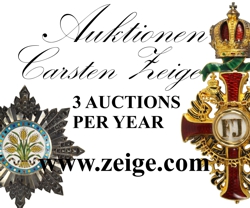House Order of Hohenzollern, Type II, Civil Division, Honour Commander Cross
SKU: 01.HOZ.0101.204.01
Estimated market value:



Estimated market value:
Attributes
Physical Description
A George’s cross, constructed of gold and enamels. The cross features outwardly rounded arms and is white enamelled with a black outline inside the white field, and a narrow gold border. A green enamelled wreath with gold borders is featured in between the arms, made of laurel on the left and oak leaves on the right (as seen from the obverse). The centre medallion is enamelled in white and features the crowned monogram ‘L’. The crown is golden with red enamel. The medallion’s ring is enamelled in blue with a gold border and features the gold inscription ‘DEN 10. FEBRUAR 1891’ (‘February 10th, 1891’) with two small decorative twigs in green and narrow gold borders at the bottom. The reverse is identical to the obverse. On loop for suspension, on a white ribbon with a narrow brown centre stripe and broad brown side stripes.
History
The House Order of Hohenzollern was founded by Prince Konstantin of Hohenzollern-Hechingen and Prince Karl Anton of Hohenzollern-Sigmaringen on December 5, 1841, and was conferred upon individuals who rendered meritorious service to the princely house.
The order originally featured five grades, including three crosses and two medals.
In 1852, the two Hohenzollern principalities were annexed by Prussia. The Prussian government expanded the order and it continued to be awarded in Hohenzollern as a princely House Order.
The order underwent several expansions and was reorganised numerous times throughout its history.
In 1866, crossed swords were added to the grades that were conferred in recognition of military merit.
In 1891, the grade of Honour Commander Cross was added to the order.
In 1910, Gold and Silver Crosses of Merit were added as grades to the order.
During the First World War, the order grades awarded with swords were conferred in recognition of outstanding leadership skills and bravery in the face of the enemy.
In 1916, the order statues were revised and it was determined that only military personnel with the rank of Major General or Colonels, who had received the II Class Decoration of a Prussian Order, were eligible to receive the Honour Commander Cross with Swords.
The order continued to be awarded throughout the Weimar Republic and the Third Reich.
In 1935, King Carol II of Romania became a prince of the House of Hollerzollern and was given the right to confer the order in Romania.

Versions
$2,800 USD
Gold/Enamelled
Obv: L. DEN 10. FEBRUAR 1891 Rev: L. DEN 10. FEBRUAR 1891
51.5x52mm
294 Honour Commander Crosses were awarded.
$900 USD
Silver gilt/Enamelled
Obv: FÜR TREUE UND VERDIENST Rev: L. DEN 10. FEBRUAR 1891
50-52mm
J.G. Zimmerer & Sohn, Sigmaringen
294 Honour Commander Crosses were awarded. Specimens of this version can also be made of gold rather than silver gilt.
$3,200 USD
Gold/Enamelled
Obv: FÜR TREUE UND VERDIENST Rev: L. DEN 10. FEBRUAR 1891
52mm
This version was awarded between 1914 and 1918. Two were awarded. Specimens in silver gilt are unofficial.


Comments
Sign in to comment and reply.


Scroll Top